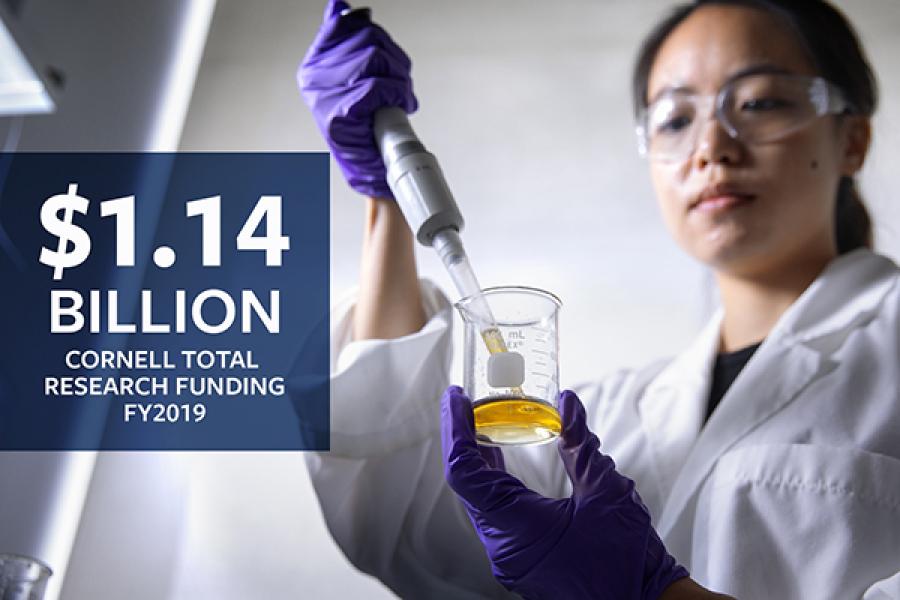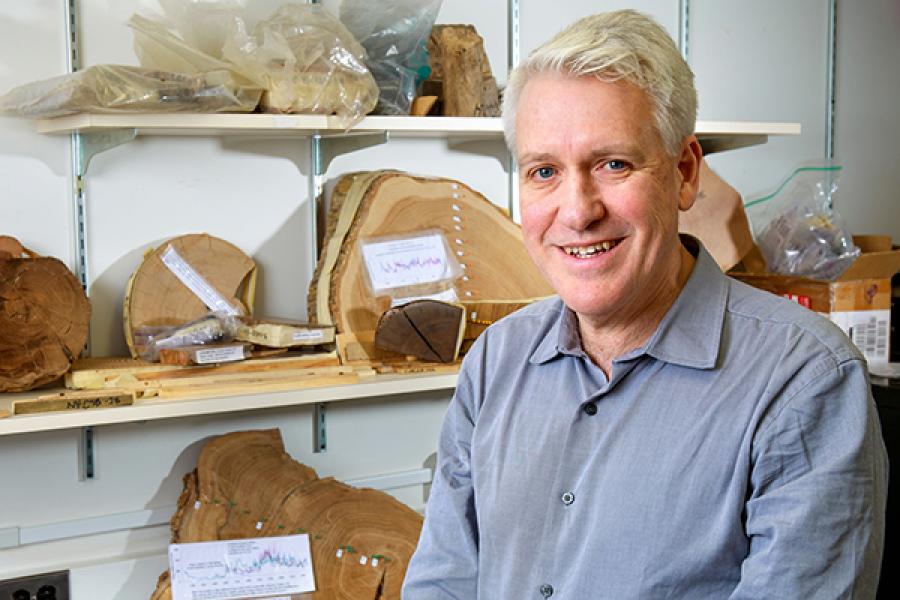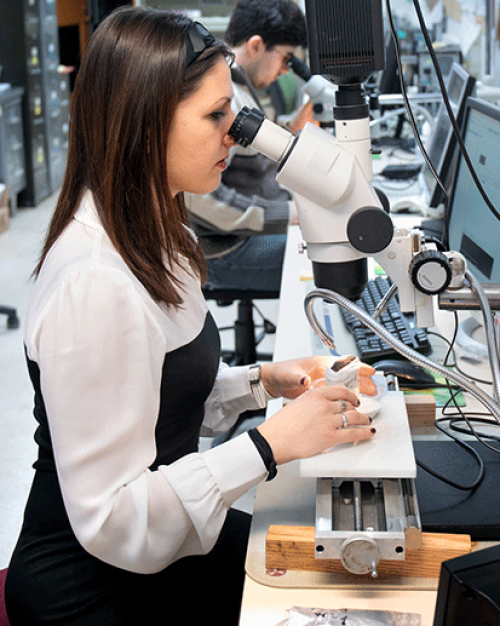Taryn Bauerle had a problem.
Bauerle, associate professor of horticulture in the College of Agriculture and Life Sciences’ School of Integrative Plant Science (SIPS), studies how root systems respond to thirst. It’s a critical area of research: Better understanding roots will help breed new drought-resistant crops, which are sorely needed to meet the global challenges of climate change, food shortages and population growth.
But digging into the ground to observe roots inevitably disrupts their environment, disturbing microorganisms and fungi, and even risks cutting into the roots themselves.
For years, Bauerle tried to work around the limitations of existing tools. Last year, while brainstorming with Johannes Lehmann, professor of soil sciences in SIPS, she had a different idea. “We quickly realized we needed a new approach,” she says, “and then we thought: Why not use biomimicry to develop some new tools?”
The team, which now includes researchers in SIPS and the College of Engineering, is developing earthworm-shaped robots that can burrow into the soil with minimal disturbance. The project received a grant from the Cornell Initiative for Digital Agriculture, which supports radical collaborations aimed at solving agri-food challenges.
“Nature has been trying to solve problems for a long time, so we’re copying what nature is already improving,” Bauerle says.
The robots, designed by Robert Shepherd, associate professor in the Sibley School of Mechanical and Aerospace Engineering, will be equipped with water-detecting sensors designed by Abraham Stroock ’95, the Gordon L. Dibble Professor and William C. Hooey Director of the Smith School of Chemical and Biomolecular Engineering.
Lehmann will explore new ways to measure soil carbon forms, and Michael Gore, Ph.D. ’09, associate professor of molecular breeding and genetics for plant quality, a Liberty Hyde Bailey professor and international professor of plant breeding and genetics, will work on initial phenotyping characterizations, to help measure plants’ properties in real time.
“It couldn’t be a better team,” says Bauerle, who brings her own expertise in root systems and below-ground plant growth. “Cornell makes it so easy to just go knock on other faculty’s doors, and everybody is always very welcoming. The innate culture that we have on this campus is that people look forward to crossing boundaries and trying new things. And I think that’s why we succeed.”
Systemic collaboration
Collaborating across disparate disciplines to tackle the grand challenges facing humanity is intrinsic to Cornell’s unique brand of research innovation. Cornell blends the intellectual capital and academic distinction of its world-class faculty with a results-oriented perspective that not only advances knowledge, but improves people’s lives in concrete ways.
“Whether it’s global development or sustainability from an engineering standpoint, from a planetary health standpoint, from a plant disease or animal disease standpoint – all of these go back to Cornell’s founding and the combination of being a land-grant and an Ivy League university,” says Provost Michael I. Kotlikoff. “Putting those two things in the same pot and churning them together results in excellence in areas you don’t often find at other institutions.”
The university facilitates innovation in myriad ways, from encouraging collaborations between its campuses in Ithaca and New York City to helping researchers take their discoveries from the lab to the living room.
Recently, Cornell climbed to No. 9 in Reuters’ “100 Most Innovative Universities” ranking, a metric based on the number of patents filed, papers published and other measures of advancing science and developing new technologies. In 2018, Business Insider rated Cornell sixth on a list of universities producing the most startup founders, with $20.1 billion raised by 750 student entrepreneurs in nearly 700 companies.
“Cornell is among the most collaborative institutions that I’ve encountered. There is a tradition of working across boundaries, which may relate to our small community and broad reach,” Kotlikoff says. “This collaborative culture drives innovation, which leaves a lasting impression on our students.”
Cornell startups are supported by a broad array of resources, including the Center for Technology Licensing, which manages technologies developed at Cornell’s campuses. The Kevin M. McGovern Family Center for Venture Development in the Life Sciences helps develop young Cornell companies, as does the Praxis Center for Venture Development, the on-campus incubator for engineering, physical science and digital startups.
Cornell Tech’s Startup Studio helps students build entrepreneurial skills and nurture ideas that may grow into real-life businesses, and the Red Bear Angels is an active network of investors who support companies founded by Cornell students, faculty and alumni.
On campus, close access to world-class thinkers, both as lab leaders and instructors, offers students depth and insight they wouldn’t encounter elsewhere.
“As a research university, we have the ability to attract scientists who are at the forefront of their craft, and then we have the ability to put these people at the front of a classroom,” says Emmanuel Giannelis, vice provost for research, vice president for technology transfer, intellectual property and research policy, and the Walter R. Read Professor of Engineering.
“At other schools, if you’re a star researcher, you might not see a classroom,” Giannelis says. “That’s not our culture here. Our teachers are on the cutting edge of the subjects they teach. And as the parent of a recent Cornell graduate and as a faculty member, I think that makes a difference.”
Combined expertise
Diversity of expertise is one factor in research excellence; diversity of backgrounds is another.
“The approaches you take, who you work with and what you work on are all influenced by your experiences and your background,” says Avery August, Ph.D. ’94, vice provost for academic affairs and professor of immunology in the College of Veterinary Medicine.
August’s efforts to boost diversity in academia include his work as a Howard Hughes Medical Institute professor, enhancing the research experience for community college students who transfer to Cornell. “We lose a lot if we don’t have the diversity that contributes to the interdisciplinary nature of our research,” he says.
August, who specializes in lung inflammation, also co-directs the new Cornell Center for Health Equity, which explores disparities in health outcomes and care within a socioeconomic context – for example, among low-income patients with asthma. “We’re looking at the issues beyond biology that affect disparities in health,” he says.
August says his research is enhanced by the breadth of knowledge among his Cornell colleagues. Combining their expertise in immunology, molecular biology and genetics, computational biology and biological statistics brings researchers closer to understanding and curing disease.
For example, John Lis, the Barbara G. McClintock Professor of Molecular Biology and Genetics in CALS, has pioneered innovative approaches for investigating the genome – methods which generate data that could unlock cures for cancer or other diseases but are too massive for humans to sort through. Cornell colleagues apply the tools of data science and machine learning to extract information from the genome using Lis’ methods.
“John’s lab has been incredibly amazing in pioneering these assays, which are outstanding sources of information,” says Charles Danko, the Robert N. Noyce Assistant Professor in Life Science and Technology in the College of Veterinary Medicine. Danko develops machine learning algorithms to analyze biological data. “But John doesn’t really have the throughput to create data for everyone in the world who wants to use these assays. Our interactions with him allow us to make small adaptations to his protocols and use them in really creative ways.”
World-class facilities
In their related work, Lis, Danko, Haiyuan Yu, professor of computational biology, and B. Franklin Pugh ’83, who holds the Greater Philadelphia Professorship in the Department of Molecular Biology and Genetics in the College of Arts and Sciences – recently recruited back to his alma mater as part of the provost’s Radical Collaboration initiative – bring their labs’ distinctive approaches to collaboratively reach solutions that wouldn’t be obvious to any single expert. They also rely on Cornell’s world-class facilities in nanotechnology, immunology and imaging, which speed the pace of innovation by making it possible to observe some of nature’s tiniest phenomena in real time.
“Imaging is a big part of this effort – and I don’t have expertise in imaging, so that has to happen through collaboration, too,” says Yu, who also is part of the Weill Institute for Cell and Molecular Biology. “Colleagues in biomedical engineering specialize in super high-resolution microscopy, to track big protein complexes throughout the transcription cycle.”
These highly specialized facilities are critical in attracting and keeping the world’s leading researchers at Cornell, Kotlikoff says. “Research is expensive, and it requires continuous investment,” he says. “One of the things we do very well at Cornell is create these core facilities that faculty can use together and exploit together, which allows us to punch above our weight.”
The Cornell High Energy Synchrotron Source – one of the nation’s only synchrotrons overseen by a university – enables research that ranges from the development of new materials to understanding historical and even prehistorical objects. Sturt Manning, the Goldwin Smith Professor of Classical Archeology in the College of Arts and Sciences and director of the Tree Ring Laboratory, said the synchrotron has been used to investigate the chemistry of ancient wood and to ask whether it might link with past major volcanic eruptions, as well as to image parts of historical paintings not visible to the naked eye on wood panels studied and dated at the lab.
Today, Manning’s lab employs radiocarbon dating and dendrochronology – counting tree rings to date the wood used in centuries-old structures – to challenge some of history’s basic assumptions. Overseas, his lab is working on samples from Cyprus, Italy, Israel, Mexico and Turkey. Closer to home, his research with collaborators at the University of Georgia and the New York State Museum strongly suggests that Iroquois settlements in New York’s Mohawk Valley and Ontario, Canada, are more than 100 years older than believed. This new timeline casts doubt on the long-accepted assumption that all indigenous people sought to collect European objects – the basis for previous chronology.
“We were so surprised with the initial results we analyzed and measured a whole second set of samples to make sure,” Manning says.
Manning attributes some of his research success to a unique system at Cornell in which doctoral students can assemble faculty committees across disciplines, keeping professors constantly interacting with colleagues in different departments. That system also offers him access to a pool of student researchers with a range of skills.
“I have students in anthropology, Near Eastern studies, geological sciences, classics and history of art, and if you’re trying to run a lab where you’re doing things from climate change to icon dating, you don’t want students coming out of any one specific program,” Manning says.
Brita Lorentzen ’06, Ph.D. ’14, was able to combine her interests in archaeology, geology and ecology as an undergraduate and graduate student researcher in the Tree Ring Laboratory.
“It’s a unique resource for Cornell students to engage in international interdisciplinary research,” says Lorentzen, who now is leading a study into Byzantine civilization at the lab as a postdoctoral researcher.
The lab is collaborating with Cornell’s new Rural Humanities initiative, an Andrew H. Mellon Foundation-supported program aiming to use the tools of the humanities to study and support life in rural America, particularly in central and western New York state. Students and researchers in the Tree Ring Laboratory are studying both indigenous settlements and dating historic structures from the 16th to 19th centuries to help residents learn about their pasts.
“History depends on a reliable time frame,” Manning says.
Science and service
For Manning’s students, Ithaca’s rural setting is ideal for collecting wood samples and studying historical buildings; for faculty members across Cornell, it offers countless opportunities to connect science with service.
Those opportunities are a major part of what drew Karl Pillemer, the Hazel E. Reed Professor and senior associate dean for research and outreach in the College of Human Ecology (CHE), to Cornell, where he co-directs the Translational Research Institute on Pain in Later Life (TRIPLL).
“Our center embraces what’s come to be known as translational research, in which one takes findings from basic research and studies and translates them into practical programs, treatments and interventions,” says Pillemer, who is also professor of gerontology in medicine at Weill Cornell Medicine. “Then we rigorously evaluate those programs and use the results to benefit scientific knowledge.”
TRIPLL recently received a $3 million grant from the National Institute on Aging to study non-pharmacological treatments for pain in older adults. Current projects include physical activity and cognitive behavioral therapy interventions; working with families to help them communicate better with their relatives’ doctors about pain; and using technology, such as virtual or augmented reality, to help them manage it.
Among Pillemer’s collaborators in this work is Sara Czaja, professor of gerontology in medicine and director of the recently launched Center on Aging and Behavioral Research at Weill Cornell Medicine, who focuses on using technology to improve the lives of older adults. With Anthony Ong, professor of human development in CHE, and Dr. Cary Reid, the Irving Sherwood Wright Associate Professor in Geriatrics at Weill Cornell Medicine and director of TRIPLL, Czaja and Pillemer recently received a grant from Cornell’s Academic Integration initiative, which aims to foster research partnerships among faculty on the Ithaca, Cornell Tech and Weill Cornell Medicine campuses.
“People aren’t going to work together unless they’re aware of each other. You’ve got to build awareness. And you need to be intentional about that,” says Dr. Gary Koretzky, Cornell’s vice provost for academic integration and director of the Cornell Center for Immunology.
In Ithaca, collaborations often grow out of a stroll down the hall, or a spontaneous conversation at Wegmans or Temple of Zeus. Partnerships can require an extra incentive when researchers are based 200 miles apart.
To encourage researchers in New York City and Ithaca to work together, the Academic Integration initiative sponsors workshops and symposiums that bring researchers into the same room; research travel grants for graduate students and faculty; and larger collaboration grants, such as the one shared by Czaja and Pillemer.
Czaja is co-leading a $4.625 million study – funded by the National Institute on Disability, Independent Living and Rehabilitation Research – to research and develop technology to improve daily life for adults living with cognitive impairments.
“If it’s well-designed and well-implemented, technology can help foster successful aging,” Czaja says. “It doesn’t replace human interaction, but it certainly can support one’s ability to remain in touch with family and friends, especially if you’re isolated, if you’re alone, if you live in a rural location, if you have mobility problems.”
Czaja hopes to work with colleagues on the Ithaca campus and at Cornell Tech to develop technology that can engage sedentary older adults; connect isolated older adults with friends, family and medical service providers; and help manage issues of memory loss in cases of cognitive impairment.
Implementing programs in both Ithaca and New York City helps researchers identify regional differences, such as a lack of transportation options in rural settings, and possible language difficulties or cultural barriers in more diverse urban areas. And working in the community, Pillemer says, not only impacts people immediately and directly – it contributes to rigorous science and continued innovation.
“We work hand in hand with elder service providers, senior centers and geriatricians,” he says. “Cornell is certainly known throughout the world as being hospitable to faculty who want to conduct cutting-edge, groundbreaking research in real-world settings.”
This story originally appeared in the online-only spring 2020 issue of Ezra magazine.






